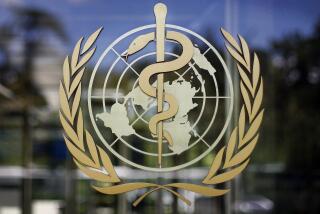Some Mexico schools, businesses reopen after H1N1 virus outbreak
- Share via
LOS ANGELES AND MEXICO CITY — Millions of students in Mexico returned to class Thursday as the country reopened universities and high schools after a two-week closure aimed at containing the H1N1 flu virus. Elementary and kindergarten classes are scheduled to resume Monday.
Museums also reopened across the country, and in Mexico City patrons again filled restaurants, bars and other public places -- although authorities required people in such venues to maintain a distance from one another.
Classrooms were disinfected before students were allowed to return.
The number of confirmed dead rose by two to 44, Health Secretary Jose Angel Cordova said. He did not give dates for the two deaths -- a 46-year-old woman from San Luis Potosi and a 23-year-old man from Tlaxcala state just east of Mexico City -- but indicated they were not recent.
A total of 1,204 people have been infected, including the dead, Cordova said. A little more than 50% of the dead lived in Mexico City.
Asked if it might be premature to reopen Mexico’s schools and other public places, Cordova said: “Clearly there is a concern on our part that by allowing these activities people may forget the recommendations we have made. That is why we insist, every chance we have, that people remember the preventive measures.”
The flu outbreak has helped push Mexico deeper into recession, Finance Minister Agustin Carstens said.
Speaking to a group of international reporters, he said the gross domestic product might contract as much as 4.1% this year because of the global economic downturn and lost business caused by fears about the flu.
And borrowing a page from Mexican drug traffickers, someone hung hand-painted signs in the city of Morelia accusing the government of lying about the flu outbreak.
Morelia is the hometown of President Felipe Calderon.
Drug smugglers often hang signs next to the people they kill, with messages for the government or police.
In Geneva, Dr. Keiji Fukuda, assistant director-general of the World Health Organization, said an H1N1 pandemic, should one occur, could infect 2 billion people, a third of the world’s population. He said it wasn’t a prediction but simply an estimate based on experience with influenza viruses.
The organization said more than 2,000 cases had been confirmed in 24 countries. The only deaths have been in Mexico and the United States, supporting the idea that the flu strain is relatively mild.
The Centers for Disease Control and Prevention said the U.S. figure had climbed to 896 confirmed cases in 41 states. The tally includes 106 cases in California, 48 in Arizona and 91 in Texas, all states bordering Mexico.
Illinois has 204 cases, according to the CDC’s count, but state authorities said 54 more had been confirmed, bringing the total to 258 and making it the most heavily affected state. The increase was attributed to the state’s ability to perform H1N1 tests without waiting for the CDC, which only recently distributed test kits to states, including California.
New details were made public about the two deaths in the U.S.
Nearly 2-year-old Miguel Tejada Vazquez, who died in a Houston hospital April 27, suffered from chronic muscle weakness, a heart defect, a swallowing problem and a lack of oxygen before he was infected, CDC experts reported Thursday in the New England Journal of Medicine.
Judith Trunnell, a 33-year-old teacher in Harlingen, Texas, suffered from asthma, rheumatoid arthritis and a skin condition, the report said. She was also 35 weeks pregnant.
After Trunnell fell into a coma in the hospital, the baby was delivered by cesarean section. The baby is healthy.
The report reinforced the idea that the virus was most dangerous to people who had underlying medical problems.
--
tracy.wilkinson@latimes.com
More to Read
Sign up for Essential California
The most important California stories and recommendations in your inbox every morning.
You may occasionally receive promotional content from the Los Angeles Times.






